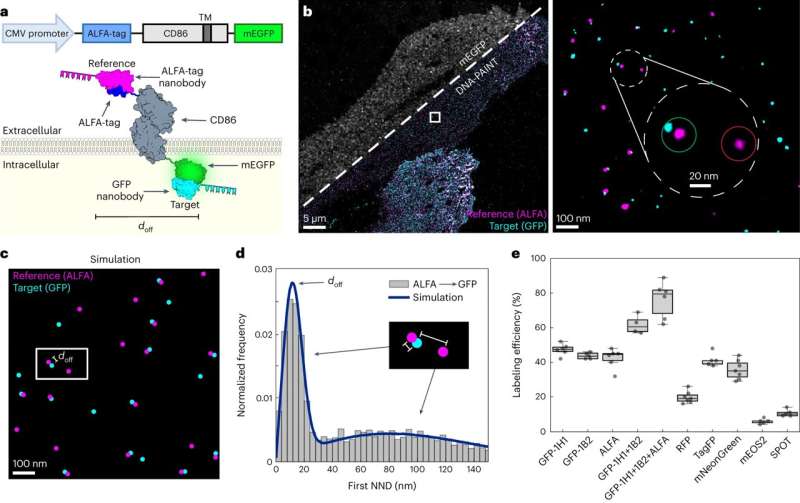This article has been reviewed according to Science X's editorial process and policies. Editors have highlighted the following attributes while ensuring the content's credibility:
fact-checked
peer-reviewed publication
trusted source
proofread
Testing how well biomarkers work: New fluorescence microscopy method can improve resolution down to the Ångström scale

LMU researchers have developed a method to determine how reliably target proteins can be labeled using super-resolution fluorescence microscopy.
Modern microscopy techniques make it possible to examine the inner workings of cells in astonishing detail. "We can now observe the arrangement and interaction of individual proteins under the microscope," says Professor Ralf Jungmann, Chair of Molecular Physics of Life at LMU and Max Planck Fellow at the MPI of Biochemistry.
The biophysicist's team recently developed the revolutionary RESI (Resolution Enhancement by Sequential Imaging) method. This technique can be used to improve the resolution of fluorescence microscopy down to the Ångström scale—far below the classical diffraction limit of light. DNA-conjugated marker molecules, which the researchers attach precisely to the molecules they want to understand better, are crucial for this.
Jungmann's team has now presented a technique in the journal Nature Methods that can be used to quantify how well biomarker molecules bind to the target proteins. "This is absolutely crucial if you want to make quantitatively reliable statements," explains the physicist.
If you know the labeling efficiency, you can carry out spatially resolved proteomics in this way. This allows you to find out not only what individual proteins do in a cell, but also to what extent they are present and how their quantity and behavior change under certain circumstances. "But this is only possible if we can assess how well the labeling has worked." This is because only labeled proteins emit flashes of light under the microscope and thus become visible.
The method developed by Jungmann's team makes this assessment possible by adding a reference biomarker to the target proteins. This marker "glows" in a different color during microscopy, so that successfully marked proteins appear in two colors.
Jungmann's team demonstrated this using the membrane protein CD86, among others: The reference produces a pink fluorescence, the actual marker a bluish one. This creates a pattern of innumerable pink and blue points of light. Where the marking did not work, only the reference lights up individually. The marking efficiency is calculated from the ratio of double and single illuminated molecules.
The method offers several advantages compared to previous methods for determining binding efficiency, "It works not only in vitro, but also in vivo, i.e. in the context of intact cells," explains Jungmann. "The technique can also be applied to a variety of different target molecules, biomarkers, and samples and is compatible with a whole range of super-resolution methods."
A reliable and widely applicable means of assessing marker efficiency is crucial to ensure accurate data evaluation and enable reliable comparisons between different binders, labeling conditions, and research laboratories.
The authors of the study are certain that the new quantification method has paved the way for significantly expanding the potential of their super-resolution microscope method, "Now we can also consider specific biomedical applications in which the quantitative detection of proteins and processes is of great importance," says Jungmann.
This includes cancer research, for example, where information about interactions between proteins on the cell surface and drugs with molecular resolution is essential for the development of new types of medication.
More information: Joschka Hellmeier et al, Quantification of absolute labeling efficiency at the single-protein level, Nature Methods (2024). DOI: 10.1038/s41592-024-02242-5
Journal information: Nature Methods
Provided by Ludwig Maximilian University of Munich


















